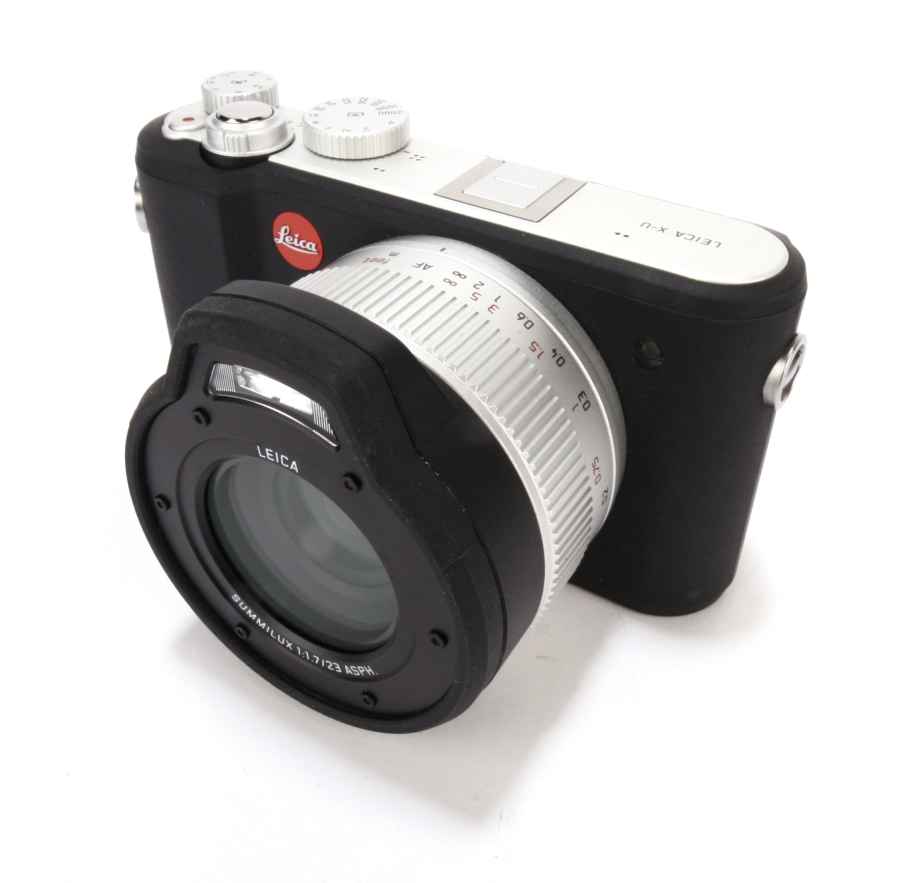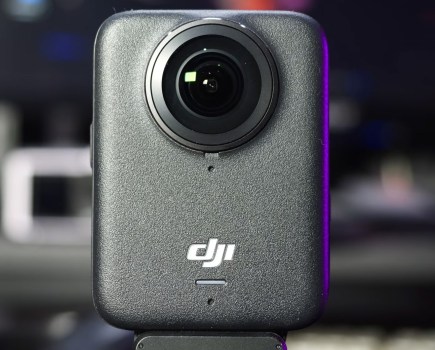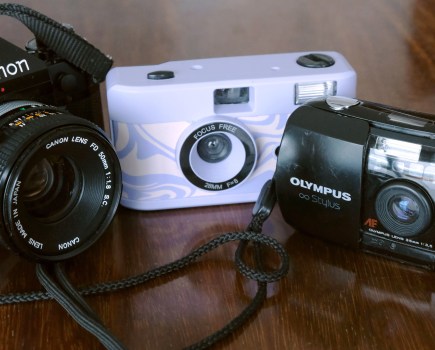I’m not usually one to hesitate when it comes to getting out with my camera at the crack of dawn, but after a tiring overnight drive to my hotel on the outskirts of Swindon and a wake-up call at the unearthly hour of 5am on a Sunday morning, it’s hard to resist pulling the duvet over my head. There’s no time for snoozing though if I’m to make it to today’s location for my field test and 20 minutes later, after a hasty shower and slurp of coffee, I’m back on the road, heading west along a deserted M4 bound for Tenby in South Wales.
Of all the places to visit at the end of February, a faraway seaside town on the Pembrokeshire coast might seem like a strange destination. However, it’s all for good reason though, and today I’m making my way to an RNLI station where I’ve arranged a place onboard one of the RNLI’s Tamar-class lifeboats, which should be the ideal testing ground for one the most intriguing rugged cameras to hit the market of late. The camera in question is the Leica X-U (Typ 113), and just like any camera that claims to be waterproof and shockproof, it merits a brutal test. After a lot of thought about how best to test it, I couldn’t think of a much better way than seeing if it could survive a soaking out at sea.

AP’s Deputy Technical Editor, Michael Topham with the Leica X-U aboard the Tenby RNLI lifeboat
My early start means I arrive in Tenby earlier than planned and my walk along the quiet path to the RNLI’s state-of-the-art lifeboat station gives me a chance to get familiar with the Leica X-U. There’s nothing much more iconic in the world of photography than the red dot of a Leica, and within minutes of pulling it from my bag I realise I’m holding onto a beefed-up Leica X with some pretty serious rubberised protection. When I used the Leica X in the past I was impressed by the results from its fixed 23mm f/1.7 lens, so I’m glad to see this optic carried across to the Leica X-U. The Leica X wasn’t a camera entirely free of niggles though, so I’m hoping to discover whether these have been ironed out. Raising the camera from my hip and taking my first shot overlooking St Catherine’s Island reminds me of how reliant I’m going to be on moving my feet to find the optimum position to shoot from – a key characteristic of using a fixed focal length lens as opposed to a zoom. I’m aware that I can squeeze a good amount of my surroundings in the frame and I’m confident that the lens will be well suited to the rather tight working environment on board the deck of a lifeboat.

The first shot of the day taken from the path to the RNLI boathouse overlooking St Catherines Island, Tenby
Upon arrival at the lifeboat station I’m greeted by David Riley, the RNLI’s deputy press officer, who introduces me to today’s crew over a warming brew. It doesn’t take long before the Leica X-U is being passed around the boathouse, each crewmember keen to get their hands on it and ask questions about its ruggedness. I want to show them just how rugged it is by dropping it from its shockproof resistance height of 1.22m onto the floor, but then I haven’t driven 250 miles to break it for nothing. Needless to say, I resist the temptation and save that test for later.
With little time to finish my tea, or explain that it’s Leica’s first attempt at creating an underwater camera, I get kitted out ready for a prompt 10am launch. I was reasonably calm back in the crew room, but as I step aboard the lifeboat my heart starts to beat a little faster, knowing that in any minute we’ll be taking the plunge down the long slipway out to sea. Switching the camera on and focusing my concentration towards capturing a few candids of the crew making their final adjustments helps to settle my nerves, and as I try to work out the best position to shoot from, coxswain Phil John asks if there’s anything in particular I’d like to capture from the training mission.
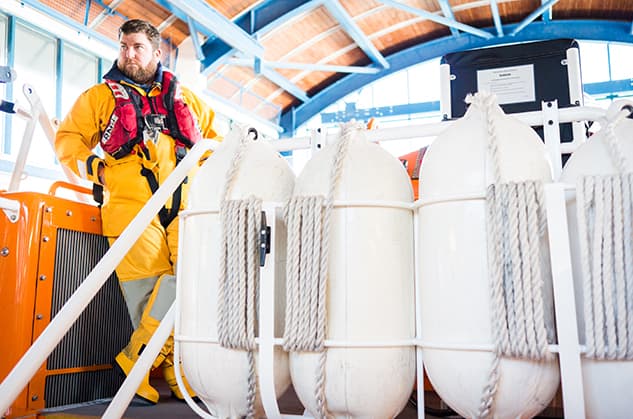
One of a few shots taken inside the boathouse to familiarise myself with the Leica X-U before the launch
I recall the last time I stepped onboard a lifeboat was to test the Nikon 1 AW1, and I handed the camera to a member of the inshore crew to capture the lifeboat launching. As dramatic as the results were, I still regretted not having the camera with me to photograph the huge wave crashing over the bow. Today, I’m keen to make sure this opportunity doesn’t pass me by, and with the permission of the coxswain, take up my position towards the rear of the aft deck on the starboard side. I’ve been picturing the potential shot for months and in any minute I should have the chance to execute it.
With the beautifully milled shutter dial set to its ‘A’ position and the smaller aperture dial set at f/2.8, I begin composing the shot using the X-U’s fixed 3in, 1.04-milion-dot screen. Having used a number of compacts with viewfinders, some being the pop-up type from the top-plate, it feels natural to lift the Leica X-U to my eye. I’m instantly aware that I’m probably going to miss having a viewfinder and I’ve always felt that framing an image via a screen doesn’t give you that same connection with the camera as a viewfinder. I’m left wishing for any type of viewfinder – even an external optical viewfinder that attaches to the top-plate mounting shoe would be better than nothing – but unfortunately Leica make no such accessory for the X-U.
The photograph I want to take is made all the more challenging by the high-contrast sunny conditions outside, which are approximately five stops brighter than inside the boathouse. Shooting at f/2.8 will allow me to keep the sensitivity low, but also get close to the Leica X-U’s maximum permitted shutter speed (1/2000sec) to freeze the water before it drowns the camera. Entering the main menu, I check the exposure metering is set to multi and dial in -1EV exposure compensation in the hope it’s enough to come away with a set of images that aren’t overexposed. As the horn blows to announce our imminent release down the slipway, I catch a glance of the top-plate and recall the continuous shooting mode being controlled from the on/off switch on the Leica X. The second I click the Leica X-U into its 5fps burst mode the lifeboat is released. ‘Not yet, not yet,’ I keep telling myself as we plummet down the slipway. A fraction of a second later, just before the bow makes contact with the sea I squeeze the shutter and hold it down as the impact wave completely obliterates the camera. Dripping wet, the camera appears to still be working, but did I get the shot? As we power towards Caldey Island at full speed I can’t resist hitting the spongy playback button to find out. Compositionally, the shots look good, however some highlight detail appears to have been lost. I just hope there’s enough leverage to pull back some the detail of the water spray from the Leica X-U’s .dng raw files later.
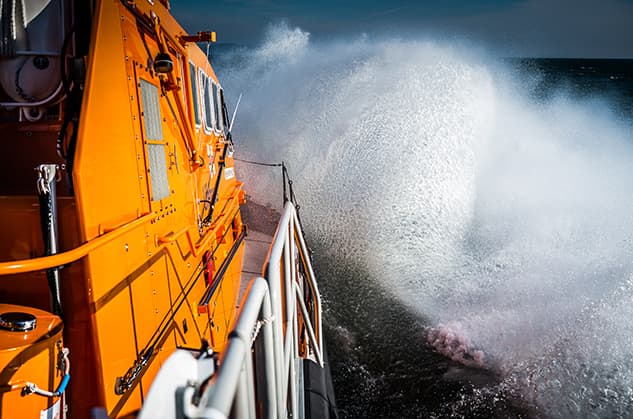
The shot I’d travelled 250 miles to take. Seconds later the Leica X-U was drenched by the impact wave
As I return to what’s going on around me, I make an effort to photograph the giant wake left in our path. Manually adjusting the aperture to f/8 and refining the exposure compensation to -1.3EV produces a better exposure in the extremely bright conditions I’m faced with. My low shooting angle is working well, but it’s frustrating to find there’s no digital level gauge to ensure the horizon is perfectly level. Glancing down at the camera, I notice the spray from the sea has left a fine mist of droplets across the lens. Before giving it a cursory wipe I take a walk around the deck, pausing briefly to take a few arty shots of a lifebuoy. The water droplets appear to be having no affect on focus accuracy, yet having to hold the AF button down for what feels like forever before I’m allowed to reposition the focus target, is starting to play havoc with my patience. It’s in times like these action photographers will want the option of being able to customise control of the AF point using four-way buttons at the rear, but instead I’m forced to keep the AF point central, focus on my subject and then recompose. As for the autofocus speed, it’s not offensively slow, but it’s no faster than the Leica X, which I hoped it might be. When I think about all the recent compact system cameras I’ve tested of late and how fast they focus, the X-U feels lethargic and somewhat dated by comparison.
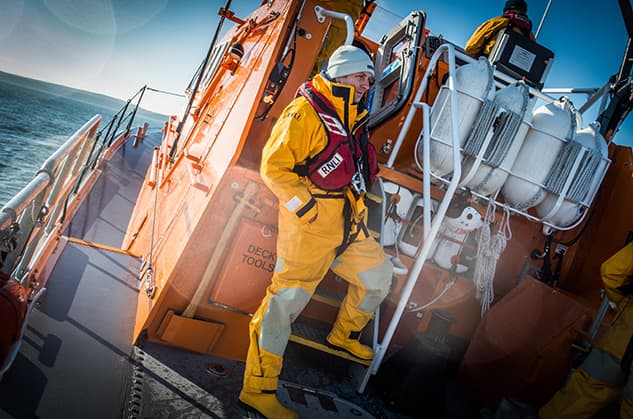
RNLI crew members prepare for the training exercise aboard the Tamar lifeboat
Asked by the coxswain if I’d like to give the camera a more relentless drenching, I enthusiastically oblige, not really knowing what is about to happen next. As I squat down to shoot two of the crew preparing to launch the inflatable Y-class lifeboat, a dramatic series of waves crash over the deck, obliterating both the camera and me. Despite being knocked off balance and being completely soaked from head to toe, the Leica X-U remains firmly in my grasp. The armoured rubber wrapped around the body provides an extremely high level of grip when wet and I’m finding the tiny rubberised dimples above the -/+ button prevent my thumb from slipping at the rear. Ten minutes later, I come up with the idea of handing the camera over to the crewmembers aboard the Y-class boat to see what they make of it. To keep things simple, I set up the X-U in auto mode and pass it over, but my confidence in the crew getting some shots from a different perspective takes something of a knock when I’m asked what should happen if it’s accidentally dropped and lost at sea. As I explain that it’s a risk I’m prepared to take, part of me regrets not requesting the optional floating strap that Leica makes for the camera to prevent it sinking out of reach. Never afraid of missing a great shot, I let the crew loose with the Leica X-U to see what they can get.
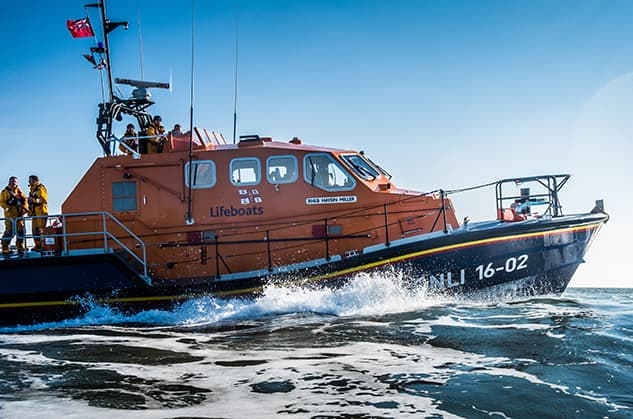
This shot was captured by the RNLI crew aboard the Y-class lifeboat looking back towards the Tamar lifeboat
Being without the camera for ten minutes gives me the chance to walk around the lifeboat to look for more shooting opportunities and soak up the breathtaking views of the Pembrokeshire coastline. After a few practice exercises and high-speed run pasts, I’m ready to get the camera back in my hands. The crew seem very complimentary of its waterproof characteristics, but as I take a quick look at the shots they have captured, my eye gets drawn to the battery level indicator, which has reduced from three bars to one within the space 390 shots being taken. To prevent running out of juice and missing out on any shooting opportunities on the return leg, I take the precautionary measure of unlocking the well-fastened battery chamber and pull a fully charged spare battery from my pocket to replace the drained one.

The extremely bright conditions served up a tough test for the Leica X-U’s metering system
Capturing a few shots of helmets, ropes and smaller details in the shade at the back of the boat presents a chance to experiment with some faster aperture settings. Working closely to these subjects reveals the Leica X-U has the same characteristic as the Leica X whereby the camera automatically stops the lens down as you focus closer, in an attempt to prevent images suffering from softness and spherical aberration. Though I can understand the thought process behind overriding the aperture to ensure that the best image quality is kept at close-focusing distances, I’m left questioning who’s in control – is it the camera or me? I strongly believe that if I set the camera to shoot at f/1.7 it should be able to shoot at f/1.7, yet the camera is insisting on overriding the aperture, typically setting it between f/2-2.8 when photographing subjects within a 0.45m-1m range. It’s rather infuriating and it feels slightly odd dialling in an aperture, for the camera to then not shoot at that setting.
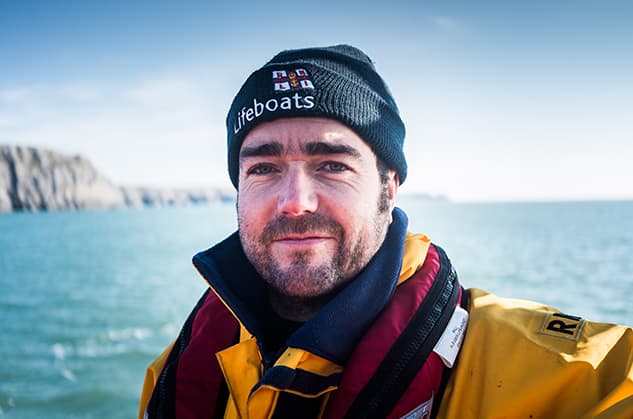
A portrait of Tenby RNLI’s Coxswain, Phil John overlooking the Pembrokeshire coast
As the crew finish their last exercise of the day, which involves gathering around the aft deck to listen to a brief on how to use the salvage pump, I can’t resist capturing a few close-up portraits. An inspection to check all is well on the rear screen shows the Leica X-U’s 16.2-million pixel APS-C size sensor is resolving exceptionally high levels of detail and the shallow depth of field that’s being created using an aperture of f/2 complements the subject of portraiture. The fixed lens, which is equivalent to 35mm, is forcing me to shoot within approximately a metre of the crewmembers, but I’m struggling to achieve a balanced exposure with the lens opened to f/2 – the mechanical shutter simply isn’t allowing me to shoot with a fast enough shutter speed.
As much as I want to stay out in the sun on the open water, I can’t wait to get back to base to take a closer inspection of my images. Twenty minutes and couple of hundred more shots later and we’re back at the foot of the slipway ready to be winched back to where we started. My last shot of two of the crew clutching ropes before they’re thrown to shore is one of my favourites, but with more than 600 others taken during the morning’s exercise I certainly have no shortage of others to choose from to edit.
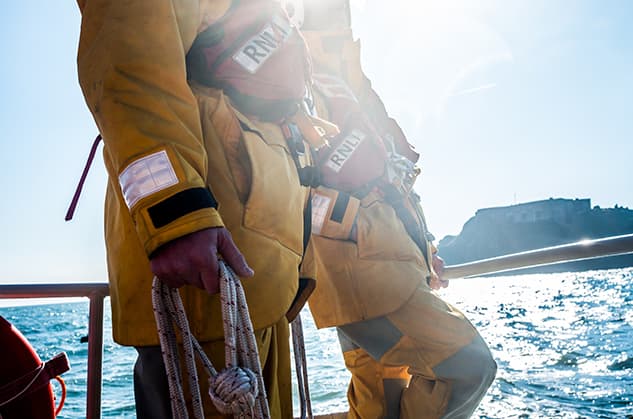
The last shot of the day prior to being winched back into the boathouse
Conclusion
Retreating back to the comfort of the crew room gives me a chance to pull up the images I’ve taken on my MacBook and reflect on today’s exhilarating experience. After importing the raw files into Lightroom, I breathe a sigh of relief when I discover the highlight detail that I originally thought was lost in my first set of images isn’t clipped after all. The extremely bright shooting conditions served up a tough test for the metering system and though I’m able to pull back detail in raw, I often found myself dialling in -1EV or -1.7EV exposure compensation to prevent overexposure. To take full advantage of Leica X-U’s fast lens and its widest aperture settings I really wanted to be able shoot faster than the maximum 1/2000sec shutter speed permitted. In my opinion, the Leica X-U is shouting out for an electronic shutter. Having the opportunity to shoot up to 1/32,000sec would allow users to exploit the fastest aperture settings no matter how bright the lighting conditions.
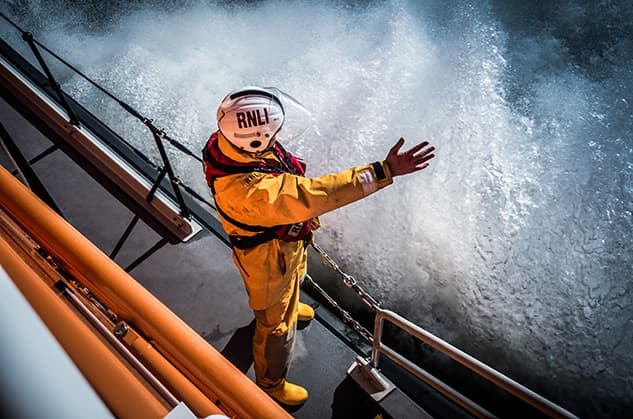
To freeze the water spray in this shot, the Leica X-U’s 1/2000sec maximum shutter speed was used
Autofocus speed and the aperture control at close working distances are other areas where I feel the Leica X-U is let down slightly. Although I’m walking away with sharp, high-resolution images that I’m pleased with, it required patience to get them. I went into this review hoping that Leica might have refined the focus algorithm to make it faster at focusing than the Leica X, but sadly this is not the case. It’s a similar story with regard to restricting the maximum aperture when working at close focusing distances. I would have liked to have seen an option added to the menu to give users the choice of whether they’d like the camera to ascertain the best aperture at short focusing distances or not.
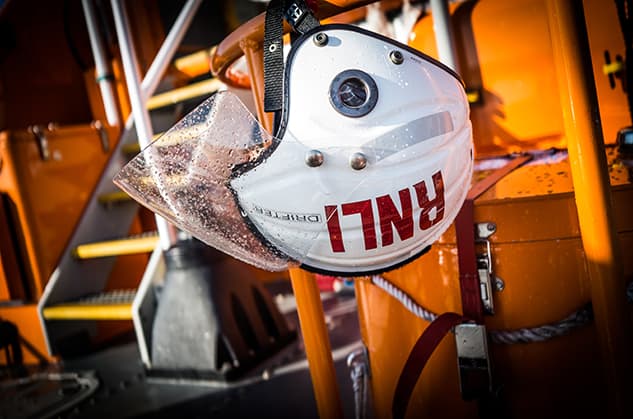
Although the aperture was manually set to f/1.7 for this shot, the Leica X-U automatically adjusted it to f/2.5
These points aside, we must remember the X-U is Leica’s first attempt at creating a tough compact and one of the key areas where it excels is its ruggedness. Despite getting drenched at sea, it showed no sign of water ingress or damage. Cameras that are designed to brush off water can be vulnerable to fogging up in humid conditions, but the Leica X-U passed this test with flying colours and later survived a rather brutal metre-high drop, directly onto its lens. The rubberised armour does a sterling job of cushioning impacts and no matter how wet the body or my hands got, it never felt like it was about to slip from my grasp.
As I start to pack up my kit and thank the RNLI crew for all their efforts, I was asked whether I’d buy the camera. What I’ve really fallen in love with about the Leica X-U is the way it lets you fully concentrate on the process of taking images rather than worrying about whether your camera is going to get destroyed in any tough environment. It’s built like a tank and it has allowed me to capture some of my best images at sea. However, I can’t help but feel that for £2,400 it’s lacking in terms of performance. With an improved autofocus system, better customisation control and an electronic shutter, Leica could really be onto something with the X-U. Although I won’t be putting my name down for one, I’d certainly consider hiring one for any professional jobs that demand an ultra-rugged compact camera in the future.
RNLI on Instagram
From crashing waves to scenic views, from Shetland in the North to St Mary’s in the South, the RNLI is lucky to have such great photographic opportunities around its coastlines across the UK and Ireland. The RNLI Instagram account (@RNLI) showcases the best photographs from a community of amateurs and professionals capturing the RNLI from many different views and perspectives through varying lenses.
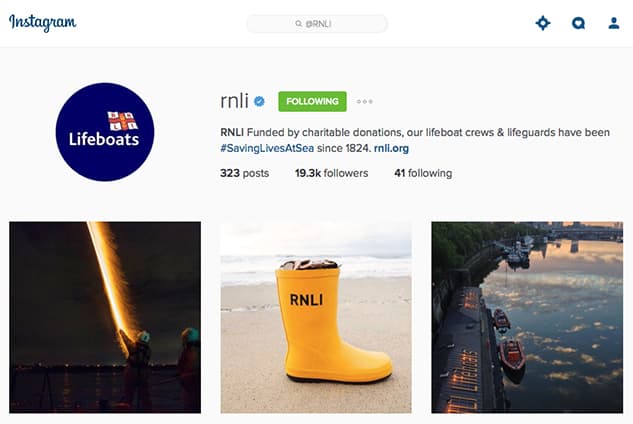
Nathan Murray, RNLI’s social media content officer says, ‘About seven in ten photos that we share on Instagram have been sourced from our online community. We’re incredibly lucky to have a network of photographers across the country continually supplying us with authentic and often incredible beautiful photographs.’
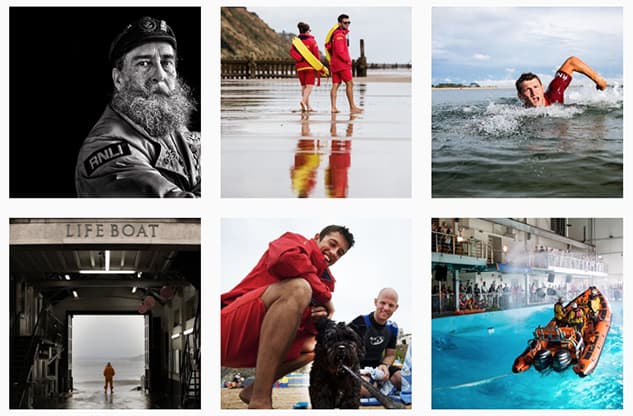
Although our coastlines can be stunning scenes for photography, the water surrounding us can be dangerously unpredictable. Find out how to keep safe and more about the RNLI’s drowning prevention campaign ‘Respect the Water’ at www.rnli.org/respectthewater.

